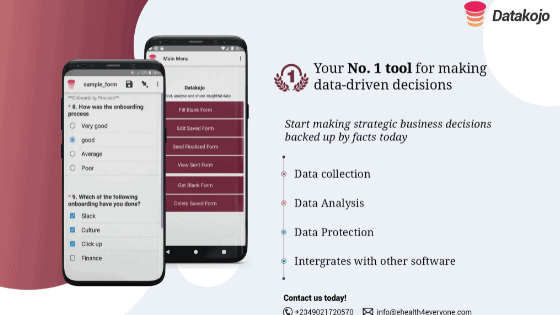Data is defined as a collection of discrete values that convey information describing quality, quantity, facts, statistics, and other basic units of meaning. It may represent abstract ideas or concrete measurements.
Data is a very important aspect of scientific research, finance, and virtually every human organizational activity mainly because it is processed into information that can be used to make important decisions. However, this can only happen after data collection and analysis.
There are two major types of data which may be further classified into the following subtypes:
-
Quantitative data:
This is data that is countable and can be expressed in numerical values. It answers questions like “how much”, “how many”, and “how often”. It is also known as numerical data.
-
Qualitative data:
This is the type of data that cannot be counted or measured in the form of numerical values. This data may consist of images, symbols or text and is usually sorted by category. It is also known as categorical data.
What is data collection?
Data collection is the process of gathering and measuring information on targeted variables in an established system, which then enables one to answer relevant questions and evaluate outcomes. It is an important research component in all fields of study.
Process of data collection
Although there are different techniques in collecting data depending on the type of data to be collected, there are general processes that still have to be followed.
-
Determine the kind of information you need:
The first thing to do is to determine what information you want to derive from the data you want to collect. You have to choose the source of your data, what subjects the data will cover and the quantity of data to be collected.
-
Establish a timeframe for your data collection:
Now that you have determined the kind of data you need, your data collection process can start. The next thing you need to do is to set a deadline for your process. This is to have a defined period for the data to be collected.
-
Select a data collection method:
Next thing is to select the method that will be used to collect the data. It is important to consider the type of data to be collected and the timeframe for the collection process while selecting the method to be used.
-
Collect the data:
Now, it’s time to start your data collection process and start collecting the data. It is important to stick to your process and check in on its progress regularly. There are various data collection tools that can be used for this process such as Datakojo.
-
Analyze your data and implement your findings:
After properly collecting your data, you need to start the analysis. This step is very important because this is where you turn your data into valuable information that can be used to make important decisions in various aspects of life. There are various tools that can be used for data analysis. An example is Datakojo, which can be used for both data collection and analysis.
Methods of data collection
There are five common methods of data collection. These are:
-
Surveys:
A survey is a list of questions aimed at extracting specific data from a particular group of people. Surveys may be conducted by phone, mail, via the internet, and also at street corners or in malls.
-
Interviews:
An interview is a conversation where questions are asked to get information. The interviewer is usually a professional or paid researcher, sometimes trained, who poses questions to the interviewee, in an alternating series of usually brief questions and answers.
-
Focus groups:
A focus group is a group interview involving a small number of demographically similar people or participants who have other common traits/experiences. Their reactions to specific researcher/evaluator-posed questions are usually studied. A focus group is also used by sociologists, psychologists, and researchers in communication studies, education, political science, and public health.
-
Questionnaires:
A questionnaire is a list of questions or items used to gather data from respondents about their attitudes, experiences, or opinions. Questionnaires can be used to collect both quantitative and qualitative information.
-
Observations:
Observation is a way of gathering data by watching behavior, events, or noting physical characteristics in their natural setting. Observations can be overt (everyone knows they are being observed) or covert (no one knows they are being observed and the observer is concealed).
Do you have an upcoming task on data collection and analysis? Use Datakojo.
Datakojo is a free, flexible, and easy-to-use mobile data collection platform used for surveys, research, and supervision.
Why you should use Datakojo
Unlike most data collection platforms, Datakojo has advanced features such as:
- A user-friendly interface,
- Data privacy, security, and encryption.
- Instant analysis and feedback of collected data.
- The ability to collect data with or without an internet connection.
To use Datakojo, visit www.datakojo.com to create an account. You can also download and use Datakojo on your smartphone. Click here to download.
External links
https://www.researchgate.net/publication/325846997_METHODS_OF_DATA_COLLECTION
https://www.ncbi.nlm.nih.gov/pmc/articles/PMC4857496/
https://play.google.com/store/apps/details?id=org.e4e.datakojo.android




